-
Countries
-
Data and Analysis
-
Special Focus
-
Crisis Responses
Dashboard/Fact Sheet
Color
-

Contact
dtmhaiti@iom.int
Language
English
Location
Haiti
Period Covered
Apr 25 2024
Apr 26 2024
Activity
- Mobility Tracking
- Event Tracking
This information was gathered following an armed attack that occurred on 25 April 2024, in the commune of Delmas, specifically in the neighborhood of Cité Numéro 2. As a result of this incident, individuals who were sheltered in three sites located in the neighborhood of Cité Numéro 2 and Carrefour Pean completely evacuated these sites, leading to the displacement of internally displaced persons (IDPs). In total, 1,629 individuals were displaced from these three sites, along with residents from the Cité Numéro 2 neighborhood. The IDPs headed towards the communes of Port-au-Prince and Delmas. Among them, 29% found refuge with host families, while 71% settled in four sites, including two newly established sites and two existing sites. Updates will be provided as the destinations of other individuals are identified.
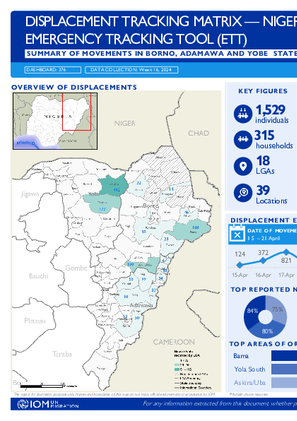
Contact
DTM Nigeria, iomnigeriadtm@iom.int
Language
English
Location
Nigeria
Period Covered
Apr 15 2024
Apr 21 2024
Activity
- Mobility Tracking
- Event Tracking
Between 15 and 21 April 2024, a total of 1,529 new arrivals were recorded at locations in Adamawa, Borno and Yobe states. The new arrivals were recorded at locations in Askira/Uba, Bama, Dikwa, Gubio, Gwoza, Konduga and Monguno Local Government Areas (LGAs) of the most conflict-affected Borno State, in Fufore, Gombi, Hong, Madagali, Maiha, Michika, Mubi North, Song and Yola North LGAs of Adamawa State and in Geidam and Tarmuwa LGAs of Yobe State.
ETT assessments identified the following movement triggers: fear of attack (500 individuals or 33%), poor living conditions (409 individuals or 27%), family re-unification (238 individuals or 15%), improved security (163 individuals or 11%), seasonal farming (113 individuals or 7%) and military operations (106 individuals or 7%).
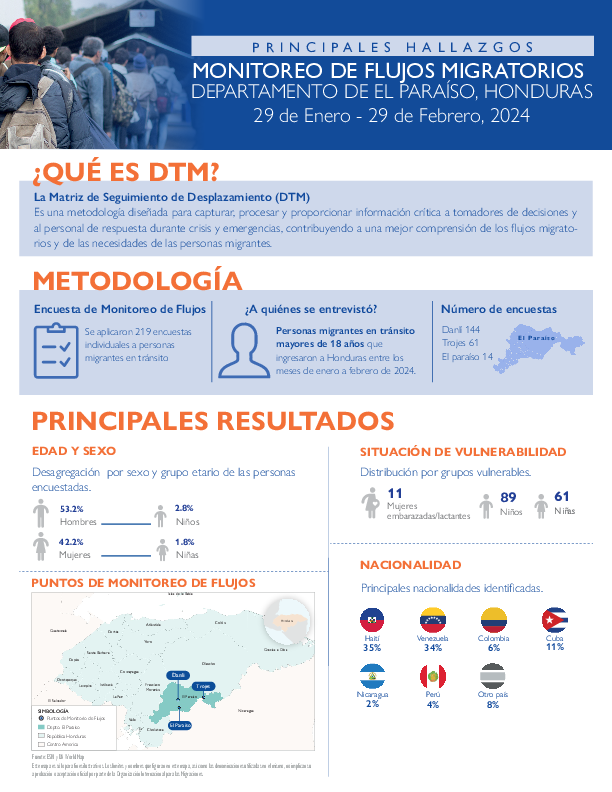
Contact
iomtegucigalpa@iom.int
Language
Spanish
Location
Honduras
Period Covered
Jan 29 2024
Feb 29 2024
Activity
- Survey
- Flow Monitoring Survey
- Flow Monitoring
Se aplicaron 219 encuestas individuales a personas migrantes en tránsito en el departamento de el Paraíso, Honduras.
- Las principales nacionales identificadas fueron de Haití (35%), Venezuela (34%), y Cuba (11%).
- 53% de los entrevistados eran Hombres, 42% mujeres, 3% niños y 2% niñas.
- Las principales necesidades mencionads fueron: Asistencia de transporte (89%), alimentación (73%), y asistencia de documentos (35%).

Contact
DTM Niger, NigerDataResearch@iom.int
Language
French
Location
Niger
Period Covered
Jan 01 2023
Dec 31 2023
Activity
- Survey
- Flow Monitoring Survey
- Flow Monitoring
- Migrants presence
- Mobility Tracking
La mobilité humaine à destination, ou à travers le Niger constitue un phénomène aux multiples dimensions et variétés. Elle comprend la transhumance, les migrations saisonnières liées à la période des récoltes, les voyages durant les fêtes religieuses, le tourisme, la migration économique vers le nord et l'ouest de l'Afrique, la recherche d'emploi, les déplacements imposés par les conflits, les catastrophes naturelles ou les effets du changement climatique, ainsi que l'exode rural. Ces éléments illustrent la diversité de la mobilité observée au Niger et dans la région de l'Afrique de l'Ouest et du Centre.
Ce rapport, élaboré à partir de données collectées de sources primaires et secondaires, vise à tracer un portrait des tendances et dynamiques migratoires du Niger, pour mieux saisir leur complexité et examiner les interactions entre les différents types de mouvements à travers le pays.
Bien que non exhaustif, ce document cherche à donner une vue d'ensemble sur la mobilité au Niger, tout en esquissant les profils des individus qui participent à ces mouvements.
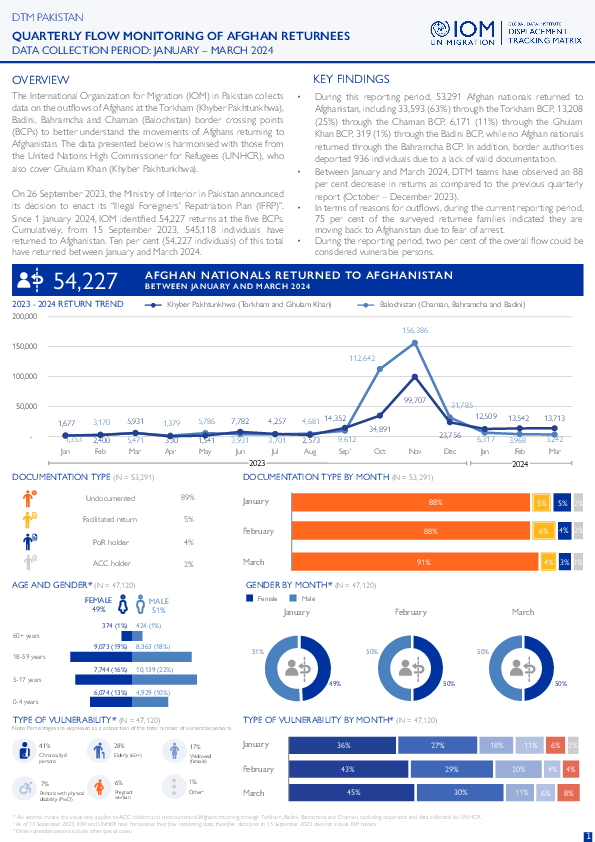
Contact
DTMPakistan@iom.int
Language
English
Location
Pakistan
Period Covered
Jan 01 2024
Mar 31 2024
Activity
- Flow Monitoring
The International Organization for Migration (IOM) in Pakistan collects data on the outflows of Afghans at the Torkham (Khyber Pakhtunkhwa), Badini, Bahramcha and Chaman (Balochistan) border crossing points (BCPs) to better understand the movements of Afghans returning to Afghanistan. The data presented below is harmonised with those from the United Nations High Commissioner for Refugees (UNHCR), who also cover Ghulam Khan (Khyber Pakhtunkhwa).
On 26 September 2023, the Ministry of Interior in Pakistan announced its decision to enact its “Illegal Foreigners’ Repatriation Plan (IFRP)”. Since 1 January 2024, IOM identified 54,227 returns at the five BCPs. Cumulatively, from 15 September 2023, 545,118 individuals have returned to Afghanistan. Ten per cent (54,227 individuals) of this total have returned between January and March 2024.
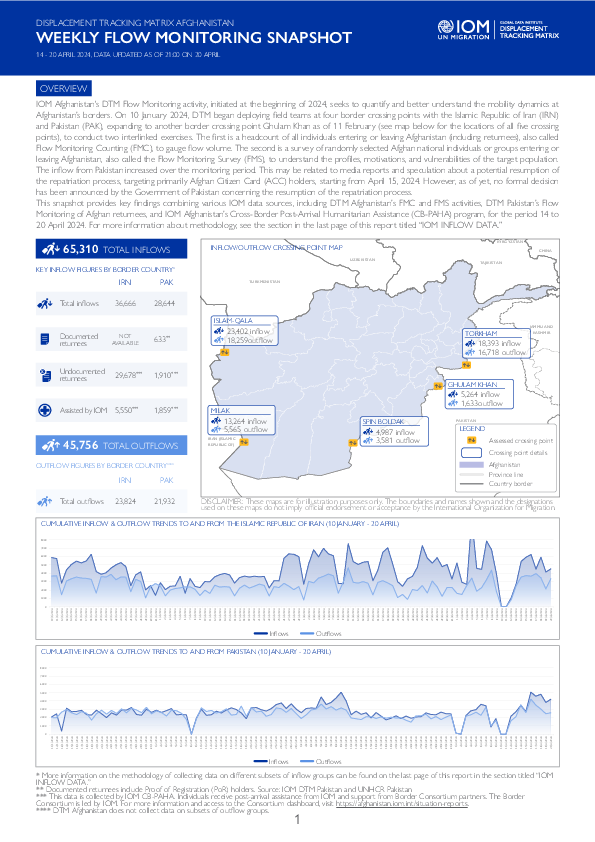
Contact
DTMAfghanistan@iom.int
Language
English
Location
Afghanistan
Period Covered
Apr 14 2024
Apr 20 2024
Activity
- Survey
- Flow Monitoring Survey
- Flow Monitoring
IOM Afghanistan's DTM Flow Monitoring activity, initiated at the beginning of 2024, seeks to quantify and better understand the mobility dynamics at Afghanistan’s borders. On 10 January 2024, DTM began deploying field teams at four border crossing points with the Islamic Republic of Iran (IRN) and Pakistan (PAK), expanding to another border crossing point Ghulam Khan as of 11 February (see map below for the locations of all five crossing points), to conduct two interlinked exercises. The first is a headcount of all individuals entering or leaving Afghanistan (including returnees), also called Flow Monitoring Counting (FMC), to gauge flow volume. The second is a survey of randomly selected Afghan national individuals or groups entering or leaving Afghanistan, also called the Flow Monitoring Survey (FMS), to understand the profiles, motivations, and vulnerabilities of the target population. The inflow from Pakistan increased over the monitoring period. This may be related to media reports and speculation about a potential resumption of the repatriation process, targeting primarily Afghan Citizen Card (ACC) holders, starting from April 15, 2024. However, as of yet, no formal decision has been announced by the Government of Pakistan concerning the resumption of the repatriation process.
This snapshot provides key findings combining various IOM data sources, including DTM Afghanistan’s FMC and FMS activities, DTM Pakistan’s Flow Monitoring of Afghan returnees, and IOM Afghanistan’s Cross-Border Post-Arrival Humanitarian Assistance (CB-PAHA) program, for the period 14 to 20 April 2024. For more information about methodology, see the section in the last page of this report titled “IOM INFLOW DATA.”
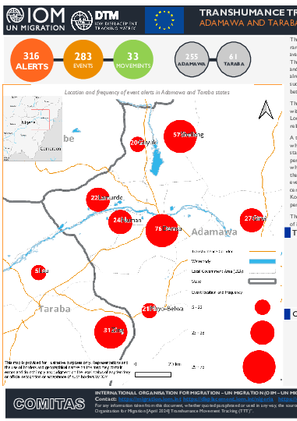
Contact
DTM Nigeria, iomnigeriadtm@iom.int
Language
English
Location
Nigeria
Period Covered
Mar 01 2024
Mar 31 2024
Activity
- Other
A total of 316 alerts were recorded in March 2024. Among these, 283 alerts (90%) were classified as events, while 33 (10%) related to movements. All alerts in Demsa, Lamurde, Girei, and Shelleng LGAs in Adamawa state were event-related. In Numan LGA, event alerts accounted for 96 per cent of reported alerts, while 4 per cent were movement alerts. Similarly, in Mayo-belwa LGA, event alerts comprised 95 per cent of alerts, while movement alerts constituted 5 per cent. In Guyuk LGA, 80 per cent of alerts were event-related, with the remaining 20 per cent credited to movement alerts. In Taraba state, Zing LGA reported 67 per cent of event-related alerts and 33 per cent are movement-related of cattle. Additionally, Lau LGA reported 67 per cent movement-related alerts and 33 per cent are event-related. Disaggregated ward-level data indicates that Kodompti and Demsa wards in Numan LGA and Demsa LGA of Adamawa state reported the highest percentage of events, each comprising 8 per cent of the total alerts.
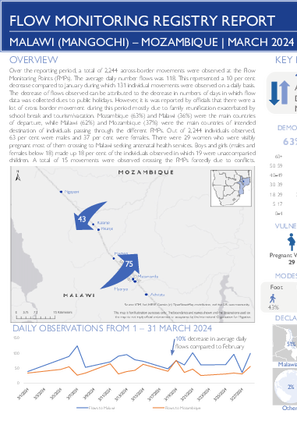
Contact
ROPretoriaRMDHub@iom.int
Language
English
Location
Malawi
Period Covered
Mar 01 2024
Mar 31 2024
Activity
- Flow Monitoring
This report is an overview of the data collected from 1 to 31 March 2024 at Mangochi FMP in Malawi along the border with Mozambique and Karonga FMP in Malawi along the border with the United Republic of Tanzania. The Flow Monitoring Registry (FMR) collects data at Flow Monitoring Points (FMPs) through direct observation and interviews with key informants, including staff working at transit stations, border patrol officers, local authorities, bus or taxi drivers and travellers themselves. The FMR gathers data on the number of travellers crossing FMPs, as well as the provenance, next destination, vulnerabilities and means of transport of travellers.

Contact
DTM Tchad, dtmtchad@iom.int
Language
French
Location
Chad
Period Covered
Jan 03 2024
Feb 08 2024
Activity
- Mobility Tracking
- Baseline Assessment
- Site Assessment
Suite au conflit armé survenu en avril 2023 au Soudan, des milliers de personnes ont été contraints de quitter ce pays pour se réfugier au Tchad, principalement à l’Est. Ces ressortissants tchadiens vivant au Soudan depuis des nombreuses années ont été enregistrés par l’OIM dans 41 lieux de déplacement dans les provinces du Sila et du Ouaddaï. La majorité (61 %) des sites de déplacement se trouvent dans la sous-préfecture d'Adre et constituent 55 pour cent de la population totale des retournés dans les deux provinces.
En effet, l’objectif de cette évaluation était de mesurer les profils, les vulnérabilités, les infrastructures ainsi que les besoins des populations déplacées à la suite de cette crise, afin de mieux orienter les résultats vers la planification de solutions durables pour les personnes déplacées. Les données sont collectées à travers des entretiens avec des informateurs clés (autorités locales, chefs traditionnels, représentants des personnes déplacées et gestionnaires de sites) dans les villages et sites d’accueil des personnes déplacées, ainsi que par des observations directes dans ces localités.
Ainsi, ce tableau de bord présente les résultats d'évaluations menées du 03 janvier au 08 février 2024, dans 41 lieux de déplacement situés dans les provinces du Ouaddaï et Sila.

Contact
DTM DRC — iomdrcdtm@iom.int
Language
French
Location
Democratic Republic of the Congo
Period Covered
Apr 18 2024
Apr 21 2024
Activity
- Mobility Tracking
- Event Tracking
Depuis le 20 mars 2024, une montée des eaux a été constatée au lac Tanganyika, à la marée de Niangara et aux débordements des rivières Mulongwe, Kalimabenge, Kamvimvira et Kabimba dans la ville d’Uvira, communes de Kalundu, Mulongwe et Kavinvira de la zone de santé d’Uvira. Ces inondations ont affecté sept quartiers (Kalundu, Namianda, Kimanga, Rombe 1 & 2, Kasenga, Kanvinvira), entraînant la destruction de biens, notamment des habitations et des terres agricoles avoisinantes. Les résidents touchés ont été contraints de se réfugier dans des zones non touchées situées dans les quartiers de Kavinvira, Kasenga, Kakombe, Rombe 1, Kimanga, Nyamyanda, Kalundu et Kabimba des communes de Kavinvira, Mulongwe et Kalundu à Uvira. Un total de 6 861 Ménages de 34 358 Individus déplacés internes dont 6 530 Ménages de 32x594 individus en familles d’accueils et 331 ménages de 1 764 Personnes dans les centres collectifs. Plus de 2 800 maisons ont été inondées lors de cet événement. Les dégâts se sont étendus à 17 écoles primaires, 20 écoles secondaires, 7 écoles maternelles et 3 universités, ainsi qu’à 9 églises locales. De plus, plus de 800 robinets d’eau potable ne fonctionnent plus correctement. Les inondations ont également touché 5 marchés importants (le Marché de Frontière, le Marché Tumaini Africa, le Marché Kunzira, le marché Zaïrois et le Marché Maendeleo). Les ports de Kalundu et de Kasenga (Port de Gaby) ainsi que la plage Maendeleo ont été submergés par les eaux. Selon les estimations, plus de 120 hectares de terres agricoles ont été inondés.
Pagination
- Previous page
- Page 14
- Next page